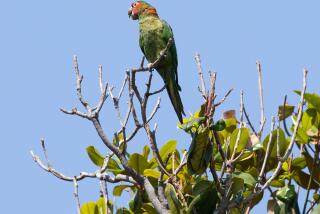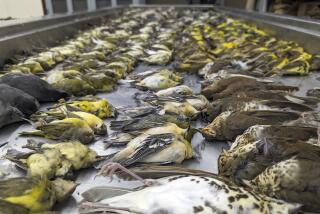Florida city overrun by a vulture culture
- Share via
BARTOW, FLA. — Residents in this quiet community are in a predicament that Alfred Hitchcock could have scripted.
About 200 ravenous vultures have ripped shingles off rooftops, chewed on the rubber seals of car doors and windows, and left behind an overwhelming stench after covering cars, roofs and sidewalks with excrement.
“They’ve multiplied. And multiplied. And multiplied until we’ve been inundated,” said Jim Spigner, president of the homeowners association at Floral Lakes, a retirement community of mobile homes where the birds roost.
Although many residents are demanding help, city officials say little can be done about the black and turkey vultures because they are protected.
Besides the federal Migratory Bird Treaty Act, vultures have added security under a bird sanctuary ordinance adopted by Bartow city officials in the 1950s, City Attorney Sean Parker said.
Federal law doesn’t allow people to trap or kill vultures, and the ordinance prohibits behavior that would “maltreat, annoy or pursue any bird.” Scaring them off could result in fees up to $500 a day, city officials said. The city plans to amend the rules but the details have yet to be worked out. Hanging up likenesses of dead vultures as a deterrent is one option.
Residents are frustrated.
James Bruce, 44, estimates damage to two family cars totals between $3,000 and $4,000. He said the birds tore the rubber seals from windows and scratched the hood and roof of his daughter’s new Ford Fusion and an older Geo Tracker.
“The Birds,” Hitchcock’s 1963 movie, is in Bruce’s thoughts as he and his family spray the birds with water to scare them away. Other residents chase them off with brooms. Some fashion their own gadgets, including wooden tablets that can be banged and sprinklers that switch on during peak roosting hours. Yet they still come back.
Spigner said the number of buzzards had drastically increased in the last two years.
“The citizen has no protection. The problem isn’t going to go away until they disturb the roost,” said Spigner, 64.
It’s unknown what attracts a group of buzzards to a certain area, Wildlife Services research biologist Michael Avery said. Avery said it was not uncommon for vultures to settle in neighborhoods. His office gets a few phone calls every week about problems from around the state. The number jumps in the months from October to March.
Wildlife biologists say it’s common vulture behavior to gnaw on rubber and vinyl because the birds use the same techniques for devouring animal carcasses. They also like to find high spots to roost.
Avery said the birds weren’t known to attack humans, although the 4- to 5-pound creatures can prey on small livestock.
He added that buzzards were an important part of the ecosystem because they cleaned up the streets by eating roadkill.
More to Read
Sign up for Essential California
The most important California stories and recommendations in your inbox every morning.
You may occasionally receive promotional content from the Los Angeles Times.













